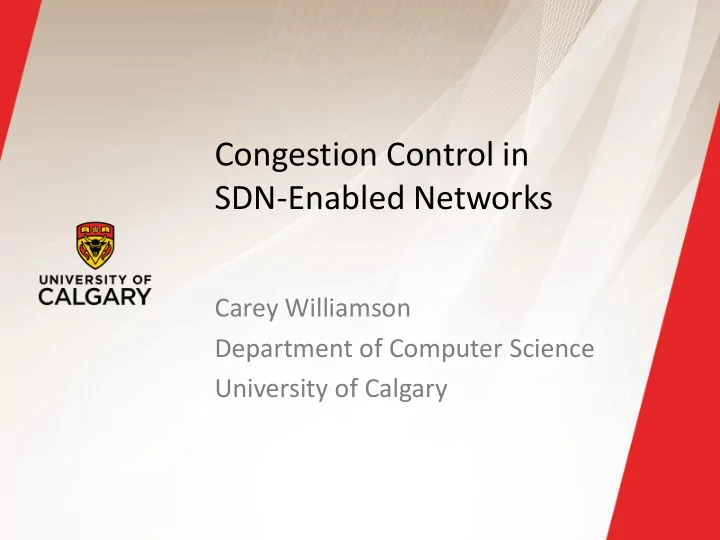

Congestion Control in SDN-Enabled Networks Carey Williamson Department of Computer Science University of Calgary
Introduction and Motivation ▪ There is a new emerging suite of high-bandwidth interactive Internet apps based on interactive video — Example 1: 360-degree video ( Sina’s MPEG-DASH paper) — Example 2: Cloud-based gaming services — Example 3: JPEG 2000 Interactive Protocol (JPIP) ▪ Challenges: — High bandwidth requirements for interactive video — Latency sensitivity for remote user interactions — Need to support multiple service classes — Overhead of resource reservation mechanisms — Limited effectiveness of end-to-end congestion control
This Paper ▪ Research Question: Can SDN provide effective and responsive congestion control for these applications? ▪ Answer: Yes! ▪ Proposed Solution: — Network-exposed API for network state visibility — SDN-assisted congestion control with low latency, high bw — Fair sharing between interactive and non-interactive flows ▪ Extensive evaluation of effectiveness and scalability A. Naman, Y. Wang, H. Gharakheilia, V. Sivaraman, and D. Taubman, “Responsive High Throughput Congestion Control for Interactive Applications over SDN- Enabled Networks”, Computer Networks, April 2018.
System Architecture
Exposing Network State Information ▪ RESTful API (HTTP-based) ▪ Registration required by interactive flows ▪ Network query response protocol for state info ▪ Request format: — GET /stats/<MyIP>/<PeerIP>/<LastIdx>/<MaxEntr>/ ▪ Response format: — Network state entries: [ns entry1; ns entry2; …] — Link state entries: [i , L, link_entry1, link_entry2, …] — Information and format: [delta_i, b_i, q_i, R_i, d_i]
Control Algorithm ▪ Two queues: interactive and non-interactive ▪ Dynamic estimation of number of bytes queued at the bottleneck point on an end-to-end path ▪ Try to limit this queue size for interactive traffic ▪ Formulas derived for control-theoretic dynamics ▪ Analogous to “Rate - Delay (RD) Network Services” by M. Podlesny and S. Gorinsky, ACM SIGCOMM 2008
Experimental Evaluation ▪ Experimental setup with Mininet
Experimental Results (1 of 12) ▪ Figure 3: Average Bandwidth (Mbps) versus Time
Experimental Results (2 of 12) ▪ Figure 4: Bottleneck Queue Size (bytes) vs Time
Experimental Results (3 of 12) ▪ Figure 5: Video Quality (PSNR) versus Time (frames)
Experimental Results (4 of 12) ▪ Figure 6: Multiple Flows
Experimental Results (5 of 12) ▪ Figure 7: Bandwidth and Queued Bytes vs Time
Experimental Results (6 of 12) ▪ Figure 8: (a) Throughput vs Time (b) RTT vs Time (c) PSNR vs Time
Experimental Results (7 of 12) ▪ Figure 9: (a) Num Flows vs Time (b) Available Bandwidth vs Time (c) Throughput vs Time
Experimental Results (8 of 12) ▪ Figure 10: (a) RTT vs Time (b) Avg Queued Bytes vs Time (c) PSNR vs Time
Federated Network Scenario
Experimental Results (9 of 12) ▪ Figure 12: Bandwidth and Queued Bytes vs Time
Experimental Results (10 of 12) ▪ Figure 13: (a) Bandwidth vs Time (b) Queued Bytes at P1 (c) Queued Bytes at P2
Experimental Results (11 of 12) ▪ Figure 14: (a) Bandwidth vs Time (b) Queued Bytes at P1 (c) Queued Bytes at P2
Experimental Results (12 of 12) ▪ Figure 15: (a) Bandwidth vs Time (b) Queued Bytes at P1 (c) Queued Bytes at P2
Conclusions ▪ SDN-assisted congestion control can provide the responsiveness needed for interactive video apps ▪ Key idea is to expose and exploit network state info ▪ Experimental results show that the proposed approach is responsive and fair, even in the presence of highly dynamic network flows ▪ Future work: — More efficient protocols for streaming network state info — More effective solutions for high-latency federated networks
Recommend
More recommend